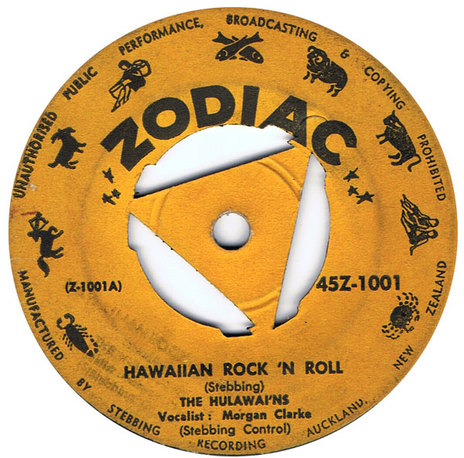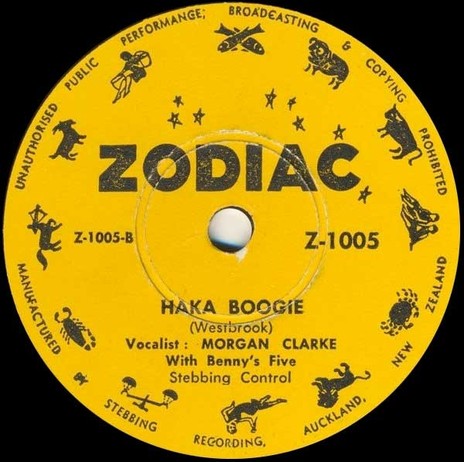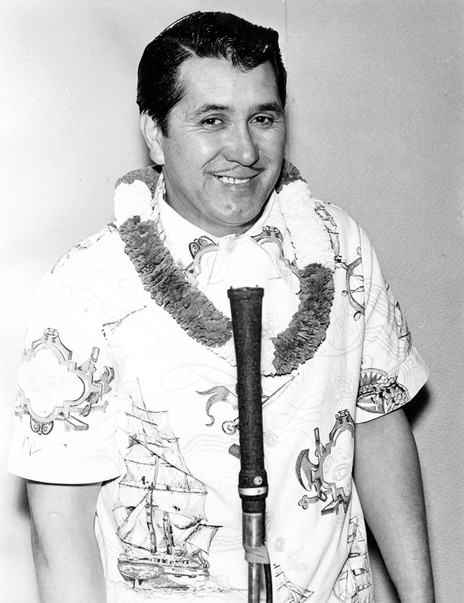Clarke was a singer who made several swaying, Hawaiian-influenced recordings for Tanza in the mid-1950s, backed by bands led by steel-guitarists Bill Sevesi and Bill Wolfgramm, the kings of Auckland’s Polynesian music scene. He then gave his music a rock and roll backbeat on songs such as ‘Hawaiian Rock ‘n’ Roll’ and ‘Haka Boogie’ – recordings that are pivotal in the development of a New Zealand-flavoured rock and roll.
On his first release for Tanza in 1955, ‘Those Kia Ora Islands’, his crooning lilt was backed by Bill Sevesi and His Island Rhythm. The song had a curious provenance: It was written by Colonel Julian G. Hearne Jr, who worked as defence attaché at the US Embassy in Wellington. (His piece ‘Kiwi Soldiers’ March’ was recorded by the US Military Academy Band of West Point’.) Clarke followed this up with ‘The Wayward Wind’ and ‘Don’t Sing Aloha’, both recorded in Auckland with Bill Wolfgramm’s Islanders.
For his next release, ‘Dreamer’s Island’, Clarke was once again backed by Sevesi – but this is where his oeuvre makes a nationalistic shift. The song was written by budding Auckland pop writer Gene O’Leary. When O’Leary began writing songs, he was told, “You can’t compete against overseas.” But his songs would soon be sharing the hit parades with foreign artists: he wrote two hits for the visiting English rock and roll singer Vince Callaher, ‘Mr Rainbow Man’ and ‘Listen to the Beating of My Heart’, both recorded with Sevesi.
Clarke moved to Zodiac, where his first release in August 1957 was credited to the Hulawai’ns. ‘Hawaiian Rock ‘n’ Roll’ was written by Phil Stebbing, brother of Eldred and an accomplished pianist. Later that year, under his own name, Clarke’s recorded ‘Hawaiian Boogie’, written by Stebbing and Lee Westbrook.
The B-side was one of the first rock and roll songs to celebrate New Zealand, ‘Haka Boogie’.
The B-side was one of the first rock and roll songs to celebrate New Zealand, ‘Haka Boogie’. Written by Westbrook, and recorded with Benny’s Five, the song is notable for its use of te reo and a dazzling steel-guitar solo by Ben Tawhiti. (There is another version in existence, with more emphatic use of te reo, and the steel solo is played by Dutch immigrant Barry Slot.)
The steel guitarist of the Hulawai’ns was Bill Taylor, from Whangarei. He taught himself by watching Auckland’s great players on the instrument, such as Mati Hita, Tommy Kahi and Tupu Waka. While Bill Sevesi was doing his army service, Taylor filled in for him at the Orange Ballroom. He was then invited to join a band called the Rhythm Rangers, who performed at the Glen Eden town hall, west of Auckland. After a couple of years they were invited to play at regular dances at the Point Chevalier Sailing Club.
In 1948 they became the Hulawai’ns, the other members being Jim McLeod on drums, Des Taylor on guitar, and Arthur Podgson on piano (who replaced Johnny Blomfield, the original pianist). Mac McKenzie, the historian of the steel guitar in New Zealand, recalled that Podgson had only arrived from England two weeks before his first gig. “He had never heard a Māori word in his life, let alone Māori music, and here he was, surrounded by it.” Podgson was also an arranger and brought many new songs to the band’s set-list during their nine-year residency at the Sailing Club.
Clarke and the Hulawai’ns recorded ‘Hawaiian Rock’n’Roll’ in 1957: it was the first disc on Zodiac to be released on 45rpm disc as well as 78rpm. The song was written by Phil Stebbing, Eldred’s older brother. The Hulawai’ns wanted an original song, Eldred explained to me in 2006. “Phil was a very good pianist, and very good organist, to the extent that sometimes when he was doing PA jobs at the Town Hall and somebody’s accompanist hadn’t turned up or something had happened, he would go out and sight read and that person would perform with him. He would play it absolutely accurately.”
“The record must have done quite well. I received a royalty cheque for 6/8.” – Jim McLeod, drummer
In the Stebbing history Wired for Sound, The Hulawai’ns’ drummer Jim McLeod recalls the recording was made in the club on a sweltering hot day. The group found it difficult to perform without an audience, and Eldred and Phil found it difficult to get a decent take; the windows and doors were shut because of outside noise from swimmers and seagulls. After many takes, there was finally one everyone was happy with. “Whenever I hear the record today,” said McLeod, “all I hear is that echo of an empty hall with a handful of people in it. The record must have done quite well. I received a royalty cheque shortly afterwards for 6/8.”
One person who never forgot seeing the Hulawai’ns as a teenager was Auckland drummer Bruce King. His second cousin, Jim McLeod, was the drummer of the Hulawai’ns – his kit had a palm tree painted on the bass drum. King was taken by his father to see the band at the Sailing Club. “I was allowed to sit behind the bandstand so I didn’t get hit by bottles,” recalled King, who would have a career of over 50 years as a session drummer. “‘Hawaiian Rock’n’Roll’ and those early hits were done live at the Sailing Club, recorded in the hall, which had a great echo.”
Although the recording careers of Morgan Clarke and the Hulawai’ns were brief, and information about them is slight, their contribution to local music was significant with the creation of ‘Haka Boogie’. The song and its performance encapsulates how a new genre of music arriving from overseas can be “recolonised” and turned into something that is unmistakably from New Zealand. Decades later, Dalvanius and the Patea Maori Club’s ‘Poi E’ and OMC’s ‘How Bizarre’ would take a similar approach and achieve worldwide acclaim.


